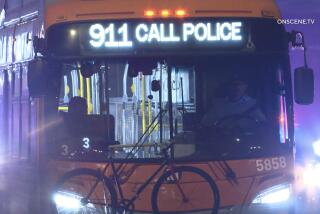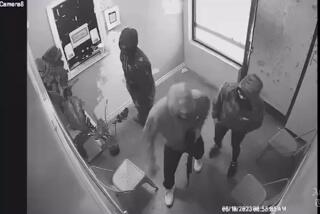The Window Watch
The commander of the California Highway Patrol’s freeway attack task force does not have all the answers to how and why more than 200 freeway motorists have had their rear windows shattered, but he said Monday that he is fairly certain about a few things:
There is more than one group of attackers. They are driving behind their victims and firing either a pellet gun or a slingshot. And they will eventually be apprehended by the CHP.
Capt. Ray Blackwell, the head of CHP investigations for Los Angeles County, said in an interview Monday that soon after the media began publicizing the incidents, they began to stray from a clear pattern.
Late Monday night, the CHP detained and then released two men in Inglewood after a motorist complained that the men were pointing an object at him that emitted a thin beam of red light. Officers said they found a “laser sight device” in the car, but were not able to determine if it could shatter glass or if the suspects had broken any windows.
“It was like a replica of a gun,” said CHP spokesman Rod Lund. “It emitted a light like a laser pointer, the kind you use when you’re giving a talk and have a big chart. . . . I doubt it’s powerful enough to blow out a window but it’s too soon to say for sure. We’ll do a photo lineup of the suspects soon and have a better idea of what’s going on.”
The CHP confiscated the device and will conduct an investigation into whether the suspects were involved in the freeway incidents.
Also on Monday, for the first time a string of incidents was reported in the San Fernando Valley, where at least nine windows were shattered, the CHP said.
“We think that there are multiple groups doing this,” Blackwell said. “I would speculate that there have been numerous copycatters.”
The first attacks Sept. 11 followed a clear route. The vandals cruised mostly along East Los Angeles and west San Gabriel Valley freeways, blowing out the rear windows of cars and trucks every several minutes.
Once the incidents gained notoriety, Blackwell said, a string of attacks along one freeway would take place at the same time as a single event on another roadway far from the original spate of incidents.
“I would imagine that we’ve got all sorts of people who would do something because someone else has done it,” Blackwell said.
“I believe that along with the attention that comes to this, comes the activity. As the interest dies down, I think a lot of the events will die down, particularly on the part of the copycatters.”
Also, contrary to what authorities had previously said, the CHP has been able to recover projectiles in some cases--the original incidents were marked by the fact that authorities were not able to recover the items that broke the vehicle windows. Blackwell would not disclose what the objects were.
As the number of incidents has increased--along with the public’s attention to them--so has the CHP’s attention. Starting with last week’s creation of the Vandal Apprehension Task Force, or VAT, the CHP began a multi-pronged offensive against the perpetrators.
At the Consolidated Operations Center downtown, most of Blackwell’s team assembles when the vandals do--at night.
As soon as CHP dispatchers receive a 911 or freeway phone box call that could be related to the string of attacks, they send the information by computer to the task force.
The operations people enter the incident into a log, send a task force officer to begin collecting evidence and wait to see if more calls roll in. By the time any subsequent calls start coming in, those in the command post have already identified patrol units in the area and directed the cars ahead and behind the string of attacks.
Since the majority of the attacks occur in clusters, Blackwell said, an immediate response increases the CHP’s chances of catching the attackers in the act.
The VAT patrol has both marked and unmarked patrols. The black-and-white cars are meant to step up response time and prevent new vandals from joining the fray, Blackwell said.
“Maybe a copycat will think twice about getting involved in that activity if they see all those black-and-whites out there,” he said. The unmarked patrols, Blackwell added, provide an additional step in the surveillance.
Finally, there are special investigators diverted to collect and examine every piece of evidence, re-interview victims, follow up on phone tips, look into trends and assemble leads from other law enforcement agencies.
Although authorities have refined their theories and sharpened their tactics for finding the vandals, the reports from victims have remained the same: A loud pop seems to come from nowhere for no apparent reason, followed by the sound of crashing glass.
“That’s what makes it scary, isn’t it--that it seems to come as a surprise,” Blackwell said. “I’ve got to tell you, I’m both surprised and grateful that no one has been injured.”
More to Read
Sign up for Essential California
The most important California stories and recommendations in your inbox every morning.
You may occasionally receive promotional content from the Los Angeles Times.









